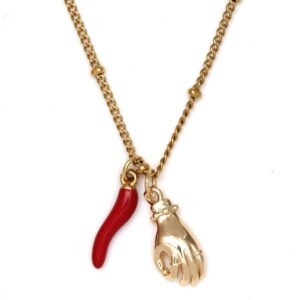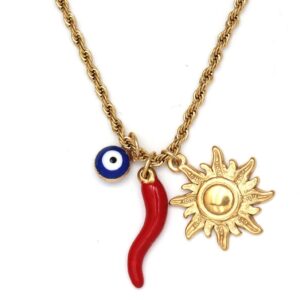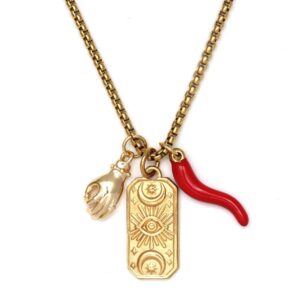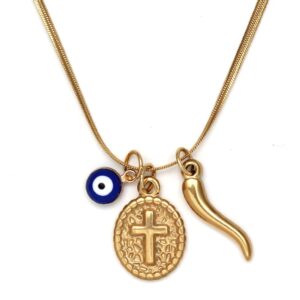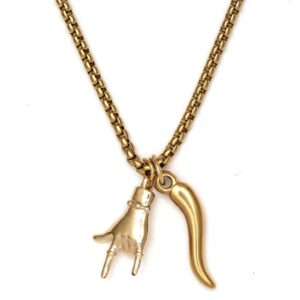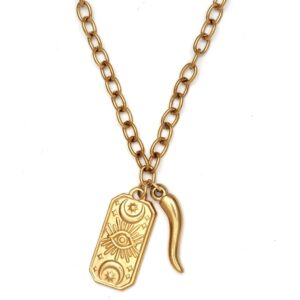Gold Italian Horn Necklaces

The Italian Horn: Symbol of Fortune & Protection
Throughout Italy, the Italian horn remains a potent symbol of luck and protection, adorning cars, streets, and cherished jewelry pieces.
Also known as cornicello or cornetto, the Italian horn’s elegant, chili pepper-shaped design dates back to ancient times, possibly linked to the pagan Moon Goddess or a bull’s horn.
Blessed with the power to ward off the evil eye, a superstition spanning millennia, the Italian horn safeguards against harm, especially to mothers and infants.
Beyond its protective properties, the Italian horn symbolizes fertility, vitality, and prosperity, embracing all aspects of life.
Crafted from materials like red Italian coral and yellow gold, each necklace holds unique significance, from protection to wealth and love.
Embrace the tradition and mystique of the Italian horn – a timeless symbol of fortune and protection.


The Meaning of Italian Horn necklaces
Italian Horn necklaces, known as “Cornicello” or “Cornetto,” hold deep cultural significance in Italian tradition. Beyond their aesthetic appeal, these necklaces serve as powerful talismans believed to ward off the evil eye and attract good fortune. The horn’s shape, resembling that of a bull, symbolizes strength, fertility, and vitality, linking wearers to ancient beliefs and the lunar goddess. Additionally, Italian Horn necklaces are cherished for their connection to heritage, serving as tangible expressions of cultural identity passed down through generations.
Crafted from various materials such as coral, gold, or silver, each necklace carries its unique symbolism. Coral, known for its protective properties, is especially revered for its ability to guard against the evil eye. Gold and silver signify wealth, purity, and resilience, enhancing the wearer’s journey with added layers of meaning.
Italian Horn necklaces are treasured adornments, worn with pride and reverence for their rich heritage and symbolism. Whether worn as a fashion statement or a heartfelt tribute to tradition, these necklaces encapsulate the essence of Italian culture and the enduring power of belief.
In the Press

Interesting Things You Need to Know About the Italian Horn Necklace
The Italian horn necklace originated in Italy, with deep roots in ancient Roman and Etruscan civilizations. Historically, it was used as an amulet to protect against the evil eye and to attract good luck. The design and symbolism of the cornicello have been passed down through generations, becoming an integral part of Italian folklore and cultural heritage. Over time, its use spread beyond Italy, gaining popularity in various cultures worldwide. Despite its broad appeal, the Italian horn remains a quintessential symbol of Italian tradition and superstitions, reflecting the enduring legacy of ancient beliefs and practices.
Wearing an Italian horn necklace carries rich cultural connotations, particularly within Italian heritage. It is seen as a symbol of protection against the evil eye, a belief deeply ingrained in Mediterranean culture. The horn also represents good fortune, fertility, and virility, reflecting ancient traditions. For many Italians and those of Italian descent, wearing the necklace is a way to connect with their roots and embrace a piece of their cultural identity. Beyond its Italian origins, the necklace has gained global appeal, with its cultural significance resonating with anyone who values its protective and luck-bringing properties.
Yes, Italian horn necklaces are unisex and can be worn by both men and women. Their design and symbolism are not gender-specific, making them a versatile accessory that appeals to a wide audience. The necklaces come in various styles, from simple and minimalist to more elaborate and decorative, allowing individuals to choose a design that suits their personal taste and fashion sense. Whether worn for its protective properties, as a fashion statement, or both, the Italian horn necklace is a universally appreciated piece of jewelry that transcends gender distinctions.

